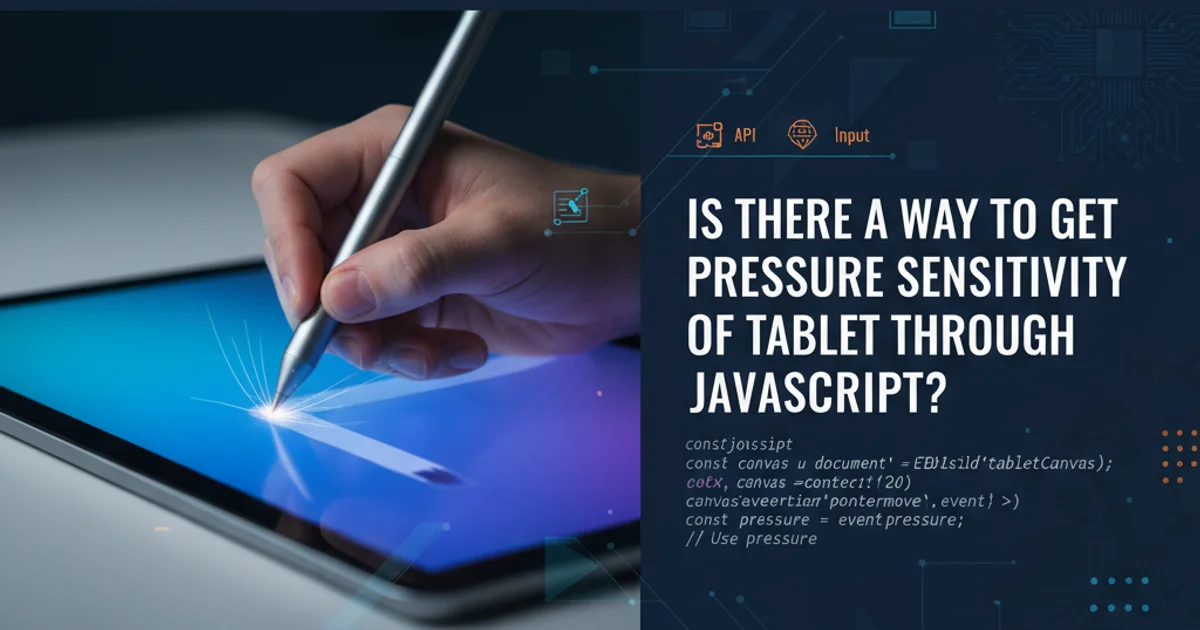is there a way to get pressure sensitivity of tablet thorugh javascript
Categories:
Unlocking Pressure Sensitivity in Web Browsers with JavaScript

Explore the current capabilities and limitations of accessing tablet pressure sensitivity data through JavaScript in modern web browsers, focusing on HTML5 Canvas applications.
Pressure sensitivity is a crucial feature for digital artists and designers using graphics tablets. It allows for dynamic control over brush size, opacity, and other parameters based on how hard the stylus is pressed against the tablet surface. While native applications have long supported this, web developers often wonder if this rich input data can be accessed directly within a web browser using JavaScript, especially for interactive HTML5 Canvas applications. This article delves into the current state of pressure sensitivity support in web browsers, primarily focusing on Google Chrome and related technologies.
The Pointer Events API: A Modern Approach
The Pointer Events API is the most promising and widely adopted standard for handling various input types, including mouse, pen/stylus, and touch, in a unified manner. Unlike traditional mouse events, Pointer Events provide a pressure property that can theoretically deliver the pressure data from compatible input devices. This property is a float value ranging from 0.0 (no pressure) to 1.0 (maximum pressure). However, its availability and accuracy depend heavily on the browser, operating system, and the tablet driver itself.
const canvas = document.getElementById('myCanvas');
const ctx = canvas.getContext('2d');
canvas.addEventListener('pointermove', (event) => {
if (event.pointerType === 'pen') {
const pressure = event.pressure;
console.log(`Pressure: ${pressure}`);
// Use pressure to control drawing properties
ctx.lineWidth = pressure * 10; // Example: line width from 0 to 10
ctx.strokeStyle = `rgba(0, 0, 0, ${pressure})`; // Example: opacity
ctx.lineTo(event.clientX, event.clientY);
ctx.stroke();
}
});
canvas.addEventListener('pointerdown', (event) => {
if (event.pointerType === 'pen') {
ctx.beginPath();
ctx.moveTo(event.clientX, event.clientY);
}
});
canvas.addEventListener('pointerup', () => {
ctx.closePath();
});
Example of using pointermove event to access pressure data on an HTML5 Canvas.
event.pointerType to ensure you are handling pen/stylus input specifically, as pressure might not be meaningful or available for other pointer types like 'mouse' or 'touch'.Browser Support and Limitations
While the Pointer Events API is a W3C standard, its implementation of the pressure property varies. Google Chrome and Edge (Chromium-based browsers) generally offer the best support for pressure sensitivity, especially on Windows with Wintab drivers or on devices with native pen support (like Surface Pro). Firefox has historically had more limited support, and Safari on macOS/iOS has its own set of challenges, often requiring specific hardware and OS versions for any pressure data. It's crucial to understand that even with browser support, the underlying operating system and tablet drivers must also expose this data to the browser.
flowchart TD
A[User interacts with Tablet Stylus] --> B{Tablet Driver (e.g., Wintab, Ink)};
B --> C{Operating System (e.g., Windows, macOS)};
C --> D{Browser (e.g., Chrome, Firefox, Safari)};
D --"Pointer Events API"--> E[JavaScript Application];
E --"Accesses event.pressure"--> F{Dynamic Canvas Drawing};
D --"Limited/No Support"--> G[Fallback to Mouse Events];
style G fill:#f9f,stroke:#333,stroke-width:2px
style F fill:#bbf,stroke:#333,stroke-width:2pxFlowchart illustrating the path of pressure data from stylus to web application.
Detecting Pressure Support and Fallbacks
Given the inconsistencies, it's good practice to detect if pressure sensitivity is available before relying on it. You can check for the PointerEvent interface and then inspect a dummy event or rely on event.pressure being non-zero for a 'pen' type. If pressure data isn't available, your application should gracefully fall back to a non-pressure-sensitive drawing mode, typically using fixed line widths or opacity.
let pressureSupported = false;
// A simple way to check for pressure support (not foolproof)
// More robust checks might involve creating a dummy event listener
// and checking if event.pressure is ever > 0 for 'pen' type.
if (window.PointerEvent) {
const testEvent = new PointerEvent('pointermove', { pointerType: 'pen', pressure: 0.5 });
if (testEvent.pressure !== undefined) {
pressureSupported = true;
}
}
console.log(`Pressure sensitivity supported: ${pressureSupported}`);
canvas.addEventListener('pointermove', (event) => {
let currentLineWidth = 2; // Default line width
if (event.pointerType === 'pen' && pressureSupported) {
currentLineWidth = event.pressure * 10; // Scale pressure for line width
}
// ... rest of your drawing logic using currentLineWidth
});
Detecting pressure support and implementing a fallback.
pressure property might return 0.5 or 1.0 even for devices that don't truly support pressure, indicating a binary 'down' state rather than a gradient. Always test thoroughly on target devices.